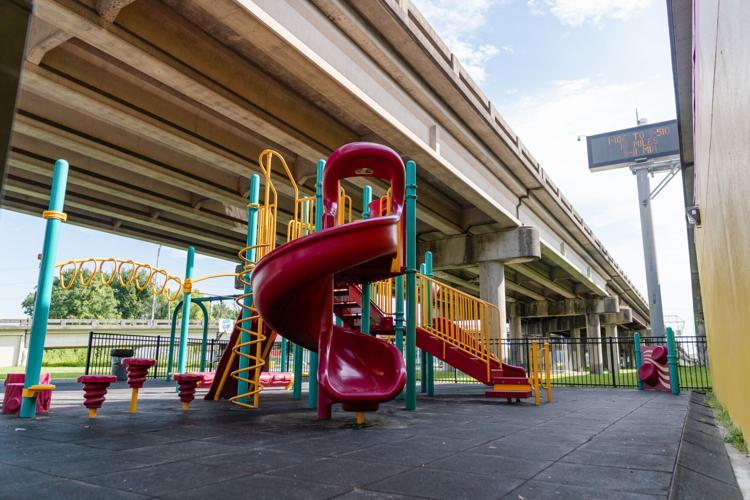A beam of sunlight illuminated the empty playground at Hunter's Field near St. Bernard Avenue in the 7th Ward this week, as it streamed through the lanes of the Claiborne Expressway.
Signage said children ages 2 to 12 were meant to play on the swing set, slide and horses on springs that sat unused and covered in dirt Wednesday, and that beckoned would-be patrons on a scavenger hunt to find pictures of fruits and vegetables hidden nearby.
But Larry Barabino Jr., CEO of the New Orleans Recreation Development Commission, sees a different future for the space, one where neighborhood kids and adults will flock to the playground and community center to play, exercise and pass on cultural traditions in danger of being lost.
"Success is being offered the programming and opportunities for the community members to come to the site and feel safe," Barabino said. "Daily usage by community members, that is success."
Barabino plans this fall to host art and hip-hop classes at the center and run sports programs out of the playground. That comes after the city and the federal government have spent nearly $2.4 million in recent years to build a new community center at Hunter's Field and to repair it. Vandals damaged the building and its still-standing predecessor, breaking lights and stealing copper wiring and fixtures. Drug use and prostitution have also been a problem at the site.
Now, some residents are skeptical about the city's latest plan to bring residents back to the space. Amy Stelly, an urban planner and artist who lives blocks from the playground, said Hunter's Field will continue to struggle to attract children as long as it is nestled under a busy interstate.
"Kids don't play here," she said, adding that the interstate should be removed so the playground can realize its full potential.
'Something for everyone'
Barabino, however, said the city's efforts are already working.
In a project that cost the city more than $520,000, workers added fencing around the amphitheater that wraps around the old Hunter's Field building, known as "The Tunnel," so no one can enter unauthorized. The city also attached a secure roll-up door to the facility.
Officials replaced the air conditioner stripped of its copper and repaired several broken windows. The city also brought on as the center's supervisor Robert Stanley, who grew up attending history, music and Mardi Gras Indian beading classes at Hunter's Field under longtime civil rights activist Jerome Smith's Tambourine and Fan program.
Jerome Smith participated in picket lines, sit-ins and Freedom Rides, endured jailings and beatings and, when he was 24 years old, confronted U.S. Attorney General Robert Kennedy in 1963 with what he said was the federal government’s failure to do more for African Americans. Here he talks about his life in a 2017 video produced for the New Orleans Recreation Department Commission.
This fall, similar classes will be offered at the center, Barabino said.
"We have partnered with a local artist, and we will be hosting starting this fall, a host of cultural classes, a host of hip-hop classes, a host of cooking classes," Barabino said. Sports teams will also return to the playground this fall, he added. "Our motto is something for everyone."
The city's work will only have staying power, Barabino added, if residents are committed to the center's success.
"The most successful parks and playground programming is led by volunteers," Barabino said. "And that's not just a local thing. That's nationally. The most successful parks and playgrounds are led by the support of volunteers, community leaders, community activists that say, 'Hey, this is our park and we want to be here with our kids.'"
Business owners, community at odds over highway
Stelly said she would love to see Hunter's Field filled with children. But she is concerned that no matter how much effort and money the city pours into the area, the noise and dirt from the highway will always be a deterrent for families.
The traffic noise starts as early as 4:30 a.m. each day. She's seen nests of discarded needles used for drugs in her neighborhood. She hears gunfire and traffic crashes and has seen prostitutes at work just outside the playground.
"I live with this every day," Stelly said, who first called for the highway to be removed more than a decade ago and has been leading the charge in earnest since 2017. "I don't understand why we, especially Black and Brown people have to always live with it. We always have to move. Or we always have to live with the dregs."
Though a 2011 University of New Orleans study found that most residents support removing the highway, many study participants said the impact of that removal was unclear, and that the removal alone would not fully solve the neighborhood's problems. A separate Environmental Protection Agency study into whether the expressway has contributed to pollution and other problems in the Treme and 7th Ward neighborhoods is underway, but won't be complete for years.
Teresa Thomas, who lives nearby and owns event venue Treme Market Branch and plant shop Crazy Plant Bae, each within blocks of Hunter's Field, said looking at pictures of oak tree-lined Claiborne Avenue before the highway makes her long for the boulevard's return. But just as the highway project destroyed dozens of Black-owned businesses in the '60s when Interstate 10 was built, she fears another yearslong highway project would destroy a new generation of businesses, including her own.
Reuben Evans, who also grew up going to Tambourine and Fan events at Hunter's Field and is involved in plans for new programming at the park, said that, whether the highway stays or goes, "Hunter's Field ain't going nowhere. I'm 100% sure."







